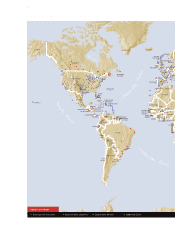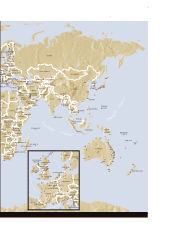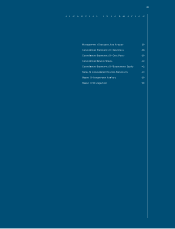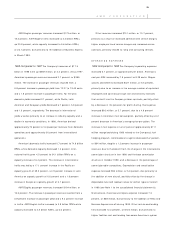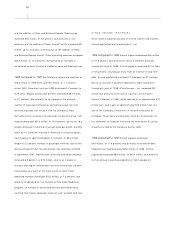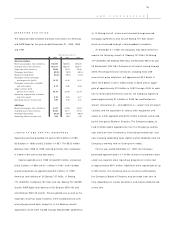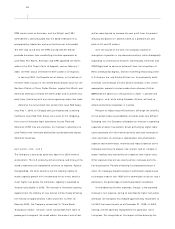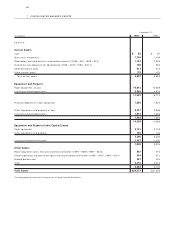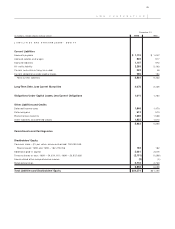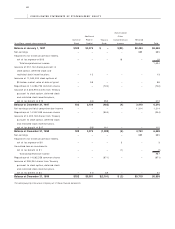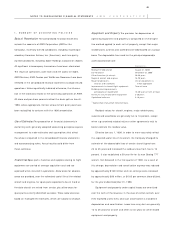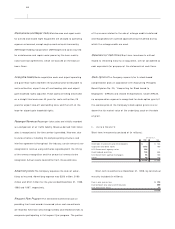American Airlines 1999 Annual Report Download - page 35
Download and view the complete annual report
Please find page 35 of the 1999 American Airlines annual report below. You can navigate through the pages in the report by either clicking on the pages listed below, or by using the keyword search tool below to find specific information within the annual report.
34
DFW carriers such as American, and the Wright and 1997
Amendments, and concluded that the Bond Ordinance was
preempted by federal law and was therefore not enforceable.
The DOT also found that the DFW Use Agreement did not
preclude American from conducting interstate operations at
Love Field. Fort Worth, American and DFW appealed the DOT’s
order to the Fifth Circuit Court of Appeals, and on February 1,
2000, the Fifth Circuit affirmed the DOT’s order in all respects.
In January 2000, the Department of Justice, at the behest of
the DOT, filed a lawsuit in the United States District Court for the
Northern District of Texas, Dallas Division, against Fort Worth and
American seeking to enforce the DOT’s order and to prevent any
party from interfering with any carrier operating under that order.
American has announced new service from Love Field begin-
ning M ay 1, 2000, to Chicago and Los Angeles and is seeking
facilities at Love Field from Dallas. As a result of the foregoing,
the future of interstate flight operations at Love Field and
American’s DFW hub are uncertain. An increase in operations at
Love Field to new interstate destinations could adversely impact
American’s business.
OUTLOOK FOR 2000
The Company is cautiously optimistic about the 2000 revenue
environment. The U.S. economy remains strong, and many of the
world’s economies are expected to continue to improve. Against
this backdrop, the chief concerns are the industry’s ability to
match capacity growth with the demand for air travel, and the
much higher fuel prices. For American, capacity is expected to
increase only slightly in 2000. The increase in American’s seating
capacity from the delivery of new aircraft will be mostly offset by
the removal of approximately 7,200 seats from its fleet. (In
February 2000, the Company announced its “ More Room
Throughout Coach” initiative, which will provide more room to
passengers throughout the coach cabins. American’s entire fleet
will be reconfigured to increase the seat pitch from the present
industry standard of 31 and 32 inches to a predominant seat
pitch of 34 and 35 inches.)
Over the course of the year, the Company expects to
strengthen its position in key domestic markets, while strategically
expanding its international network. Domestically, American and
AMR Eagle look to continue to benefit from the integration of
Reno and Business Express, and the marketing relationships with
U.S. Airways, Inc. and Alaska Airlines, Inc. Internationally, while
American will introduce minimal service increases, it will, where
appropriate, expand its various code-share alliances. Further,
oneworld will admit two new partners in 2000 – LanChile and
Aer Lingus – and, while losing Canadian Airlines, will look to
otherwise buttress its position in Canada.
Pressure to reduce costs will continue, although the volatility
of fuel prices makes any prediction of overall costs very difficult.
Excluding fuel, the Company anticipates an increase in operating
expenses of about five percent, driven primarily by higher labor
costs associated with the normal seniority and scale increases in
union contracts, an increase in depreciation and amortization
expense and maintenance, materials and repairs expense as the
Company continues to acquire new aircraft, and an increase in
airport landing fees and facility rent expense from higher rates.
Other expense lines will see volume-driven increases and infla-
tionary pressures. Partially offsetting this expected increase in
costs, the Company expects savings in commission expense due
to changes made in late 1999 to the commission structure, and a
decrease in the percentage of commissionable transactions.
Overshadowing all other expenses, though, is the expected
increase in fuel expense, owing to significantly higher fuel prices.
Although the Company has hedged approximately 48 percent of
its 2000 fuel requirements as of December 31, 1999, its 2000
earnings will be adversely impacted by this significant rise in
fuel prices. The magnitude of this impact will be driven by the



